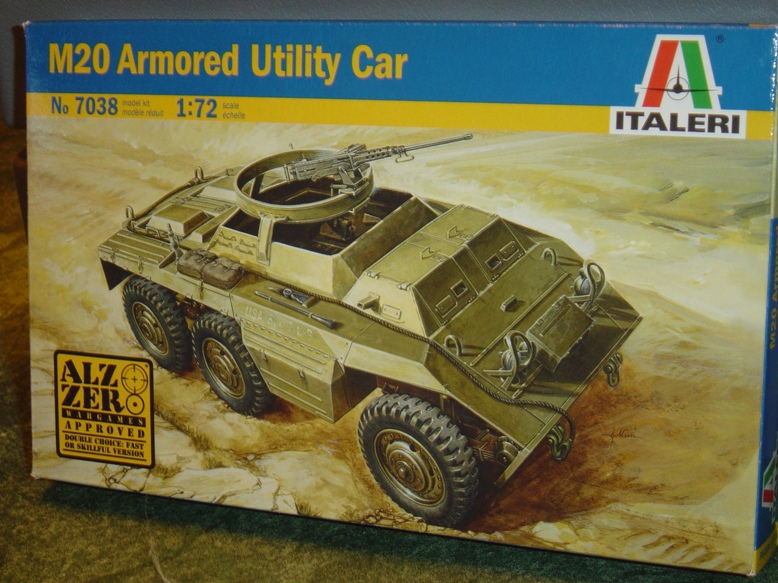|
| Please Support our Sponsors | ||||
 |
 |
1/72 Italeri M20 Utility Car Model Kit Review
By Patrick Keenan - Editor

Basic Item Information
|
Item |
M20 Armored Utility Car |
|
Stock Number |
No. 7038 |
|
Manufacturer |
Italeri |
|
Scale |
1/72 |
|
Medium |
Injection Molded Plastic |
|
Kit Contents |
68 olive drab colored pieces |
|
Retail Price |
$14.95 USD |
|
Reviewer |
Patrick Keenan |
|
Review Date |
June 29, 2006 |
Review Summary*
|
Review Type |
Quick Build Review |
|
Basic Positive Features |
Fidelity and quality of part details |
|
Basic Negative Features |
Pioneer tools molded directly on hull.; No fenders provided. |
|
Overall Rating |
3.0 of 5.0 |
|
Kit Accuracy Rating |
3.0 |
|
Parts Fit Rating |
3.0 |
|
Parts Casting Quality/ Detail Level Rating |
3.5 |
|
Decals, Marking/ Painting Information Rating |
3.0 |
|
Instructions/Packaging Rating |
2.5 |
|
Recommendation |
Recommended |
* For information regarding the review terms, grading scale, etc. please go to the WarWheels Review FAQ/Key
___________________________________________________________________________________________________
Photos
Detailed Review
|
Background |
|
To be honest, I am not a small scale (Braille scale) modeler, but I have been building more of these smaller scale kits lately and I am definitely enjoying myself more than I anticipated. One of the things I’ve noticed with newer molded small scale kits is their excellent detail when compared to older kits. The 1/72 Italeri M20 Utility Vehicle is no exception. One interesting option Italeri has provided in this kit is they’ve tried making the kit marketable to both static model builders such as ourselves AND to wargamers. On the box it states the kit is “Allzero Wargames Approved – Fast of Skillful Version”. I love the wording they’ve used. Anyway, they’ve provided a build option (with the appropriate instructions) where the construction of the kit is simplified for wargamers, who may not want to put in a lot of work to obtain a basic vehicle model for their wargaming needs. To accomplish that aim, Italeri provided alternate pieces for a simplified chassis and suspension as well as instructing the wargamer to omit some of the detail pieces; In the interior mostly. Also, the simplified suspension makes the model sturdier for active “use” by the wargamer (e.g. moving it around). Surprisingly to me, Italeri has not shortchanged us modelers by providing this “fast” option available to our wargaming brethren. Usually when a company tries to make everyone happy, they make no one happy. This is not the case with the M20 kit. I think they did a fairly good job at being able to capture the interest of both the static modeling and wargaming communities without shortchanging the other group. |
|
Kit Accuracy |
|
I compared the kit’s details and dimensions to the references I have in my possession, most notably a set of scaled down plans of the wonderful 1/35 line drawings by George Bradford of AFV News fame. All in all, the dimensions and details look accurate in most respects. However, the kit looked a bit short in length to me, although not enough to bother me personally. |
| Fit of Parts |
| For the most part, the fit of the parts/pieces was good. I found the suspension a bit “fiddly”, but that could easily be due to my lack of experience with small scale kits. I used no putty when building the kit, although I did have to use a bit of force or “heavy-handedly convince” a couple of the parts together, most notably the upper and lower hull. Other than that, I encountered no problems when building the kit nonetheless and had no instances of wanting to go get a “drink”, pitch it out a window, or stomp on it and then kick it across the room. |
|
Quality of Casting/ Detail Level of Parts |
|
The quality of the casting of the kit pieces was very good, especially when considering the fact that the kit is tiny. I found the casting quality as good as some of Italeri’s best newer releases in 1/35. There was very little flash present on the parts, and even the smallest pieces were well cast. Also, only a few sink holes were present as well. Most of the sink holes were in areas that wouldn’t be seen after the kit was built, so no major filling was needed. The detail provided by Italeri on their parts was also very good, although they have made what I feel are strange decisions of what details to provide and how to engineer them in some cases. In fact, some of their decisions in this aspect left me scratching my head wondering what they may have been thinking. I’ll delve a bit more into this subject later in this review. Anyway, with the parts they did provide in the kit, most of them were exceptionally well detailed when considering the small size of the kit. The detail on the remaining parts was no worse than VERY GOOD. I was really impressed with the detail of the Browning .50 caliber heavy machine gun, tires/wheels and upper hull. To get back to the subject where in my opinion, Italeri has made some rather “interesting” choices on what detail to provide and how to do it, the first comment has to do with the fenders. That is, Italeri doesn’t provide any. This is not a huge “problem” since many of the M8 Greyhounds and M20 Utility cars either had the fenders removed or they were knocked off during use. In fact, I like the “hot rod” look of these vehicles without the fenders. However, it would have been nice for Italeri to have provided this option, as fenders were common on the vehicles, partially or fully. To me, another puzzling decision Italeri has made is to provide molded on pioneer tools (shovel, axe, etc). That is they chose to mold the upper hull and pioneer tools into one piece. Although admittedly they look pretty good when compared to the old kits from “back in the day”, the effect is not nearly as good as if they would have just provided the pieces individually. To be honest, I am completely stumped by this decision since it is very inconsistent with how they engineered the rest of the kit. They have created a state of the art 2006 era small scale kit, yet they reverted back to circa 1975 and molded on the pioneer tools. Go figure. |
| Decals, Marking Information and Painting Information |
|
Although the decal sheet is a bit smaller than I am used to when modeling 1/35 subjects, they are well printed and appear very thin, yet sturdy. Italeri provides markings for 3 U.S. vehicles, but since M8’s and M20’s didn’t sport many markings normally, the ‘small’ decals sheet is not a problem what-so-ever. The painting and marking information provided is good, and Italeri has included a color painting diagram on the back of the kit box. Again, as the Greyhounds and M20’s weren’t garishly marked normally, the color diagrams weren’t necessarily needed for this vehicle. There are many others where the color markings information would be a definite plus. However I still appreciate having more information provided by Italeri, rather than not enough. |
| Instructions/Packaging |
|
The instruction sheet is “typical Italeri” and posed no problems using easily. The kit box sports the new blue and yellow Italeri motif which has been the norm recently. I like this design very much when compared to older incarnations of Italeri boxed kits. Plus, they appear a bit sturdier than the older boxes as well. However, Italeri continues to follow a practice I personally do not like at all; That is, they use “side open” boxes and do NOT internally bag their kit parts. I have experienced a fairly large number of instances where Italeri kits I’ve purchased at retail outlets (or even worse, secondhand) where pieces were lost, broken or a combination of two. Of course this happens with all manufacturers’ kits, but I have experienced what I feel is as a disproportionate number of these cases with Italeri when compared to other manufacturers’ kits. In my opinion, this higher rate of parts problems stems from Italeri’s use of the “side open box” and/or lack of internal bagging. To me, either of these packaging options would facilitate parts loss, but combined together makes this situation even worse. |
| Conclusion |
|
All in all, Italeri has produced a very nice kit in this small scale. I had a very enjoyable time building it and it looks good when finished. The detail is very nice in most cases, and exceptional in most others. The kit had a few small negative aspects but except for one of them, really don’t take away from the pleasing final result. If I were “running” Italeri, the only thing I would definitely change with this kit is I would provide the pioneer tools via separate pieces, not molded into the upper hull. Other than that, Italeri has produced a very good kit. Thanks to John Noack of IPMS/USA for providing the review sample to me. Recommended |
| Copyright: Patrick Keenan - June 2006 |